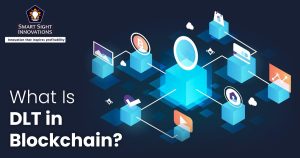 Maintaining records has been essential to civilization throughout human history. The ability to track and store information has underpinned everything from trade and commerce to governance and social order.
Maintaining records has been essential to civilization throughout human history. The ability to track and store information has underpinned everything from trade and commerce to governance and social order.
In the midst of the digital revolution, a new paradigm is emerging for record keeping known as Distributed Ledger Technology (DLT). This article explains some of the key aspects of this technology and its impact on various industries.
What Is DLT?
DLT is a decentralized database system that distributes and replicates data across a network of computers or nodes. It empowers each node to hold a copy of the ledger, creating a tamper-proof record of all transactions. Think of it as a transparent, shared spreadsheet accessible to everyone on the network.
Key Components of DLT in Blockchain
Understanding the key components of DLT is akin to grasping the inner workings of this revolutionary technology, paving the way for deeper appreciation and engagement in its boundless potential.
1. Decentralization
As each node in the network holds a copy of the ledger, it creates a distributed repository of information resistant to manipulation and centralized control. This fosters trust through transparency, as any attempt to alter the data would require simultaneous changes on every node, an almost unconquerable feat.
2. Immutability
Once a transaction is verified and added to the ledger, it becomes a permanent part of the chain, which can be traceable forever and is tamper-proof. This ensures an unbroken record of events, safeguarding against fraud and promoting accountability.
3. Consensus Mechanisms
Consensus mechanisms form the crux of DLTs, where distributed algorithms ensure network agreement on the authenticity of transactions. Popular mechanisms like PoW and PoS incentivize honest participation and prevent malicious actors from disrupting the network.
4. Cryptography
Advanced cryptographic techniques like hashing and digital signatures secure the transactions and identities within the network. Data is encrypted to prevent unauthorized parties from deciphering it, while digital signatures act as unique fingerprints.
5. Smart Contracts
Smart contracts are automated programs which are coupled with blockchain technology that automatically define and enforce contract conditions based on predetermined criteria. This eliminates the need for intermediaries, streamlines processes, and reduces the risk of human error or manipulation.
6. Network Governance
Depending on the specific implementation, participants may vote on protocol changes, fee structures, or even dispute resolution mechanisms. This empowers the community to shape the evolution of the network, fostering a sense of ownership and shared responsibility.
7. Interoperability
Disparate blockchain networks can communicate and exchange data securely. Interoperability holds immense potential for unlocking the true power of blockchain by enabling cross-chain transactions and collaboration.
Why Is DLT Important?
In the whirlwind of technological advancements, DLT stands out as a game-changer for the following reasons:
1. Security
Imagine a fortress that has innumerable walls and drawbridges instead of just one. That’s the essence of DLT’s security. Data isn’t locked in a single vault but distributed across a network of computers, making it incredibly difficult to breach. This decentralized nature empowers DLT with several security advantages:
-
Tamper-Proof Records
Once a transaction is added to the ledger, it becomes part of a permanent, unalterable chain. No single entity can manipulate data without impacting the entire network.
-
Enhanced Traceability
Every transaction is transparently visible to all participants, ensuring accountability and making it easier to track fraudulent activity.
-
Resilience Against Attacks
Even if some nodes experience outages or attacks, the network remains operational, making it highly resistant to disruption.
2. Transparency
-
Reduced Operational Costs
Eliminating intermediaries and automating processes streamlines operations, leading to significant cost savings.
-
Increased Efficiency
Faster transaction processing and real-time data availability improve efficiency across various sectors.
-
Empowered Individuals
Users gain greater control over their data, deciding what information they share and with whom, boosting privacy and self-sovereignty.
3. Trustworthy
- Contracts execute automatically, eliminating the need for intermediaries and human error.
- Secure identities empower individuals to control their digital footprint and access services seamlessly.
- Data becomes a shared resource, fostering collaboration and innovation in ways we can only begin to imagine.
DLT vs Blockchain
There are multiple ways DLTs can operate and blockchain is a particular type of DLT. DLT is the umbrella term encompassing various systems with decentralized data storage and security features.
A blockchain utilizes a linear system of blocks to record and verify information. So it would be fair to say that blockchain is a subset of DLT, similar to a sports car inside the larger auto industry.
Understanding their unique characteristics is crucial for selecting the best technology for your needs. For example:
- For cryptocurrency applications, blockchain’s strong security and established ecosystem might be ideal.
- For diverse applications requiring flexibility and scalability, DLT with its variety of structures and consensus mechanisms might be more suitable.
We look at how blockchain and DLT perform in specific aspects to get a fair idea of their applications.
1. Structure
- Blockchain
Data is arranged in a linear chain of blocks, where each block links to the previous one.
- DLT
Data structure is more flexible, allowing it to be organized in various forms. This allows for different forms like directed acyclic graphs (DAGs) or permissioned ledgers that can cater to diverse needs and applications.
2. Scalability
- Blockchain
As the chain lengthens, processing transactions on a blockchain can become slow and cumbersome. This scalability challenge often hinders blockchain’s wider adoption in high-volume transaction scenarios.
- DLT
With its flexible data structures and diverse consensus mechanisms, DLT demonstrates greater potential for scalability. This makes DLT a compelling choice for applications requiring fast and frequent transactions.
3. Consensus Mechanism
- Blockchain
Proof of Work (PoW) is the dominant consensus mechanism in popular blockchains like Bitcoin. While secure, PoW is computationally intensive and energy-consuming.
- DLT
DLTs employ a wider variety of consensus mechanisms, including Proof of Stake (PoS), Byzantine Fault Tolerance (BFT), etc., offering faster transaction processing and reduced energy consumption while maintaining security and consensus.
4. Scope and Applications
- Blockchain
Blockchain is often linked to cryptocurrencies and digital assets, but it also has a place in secure data storage and financial applications. Its robust security and established ecosystem make it ideal for high-value transactions and asset management.
- DLT
DLT’s versatility shines in its diverse applications across industries. From supply chain management and healthcare to voting systems and identity management, the possibilities are boundless. Its flexibility and scalability make it adaptable to various needs and requirements.
5. Tokens
- Blockchain
Tokens are an important factor when working with blockchain technology.
- DLT
Tokens are not necessary when working with DLT as its overall ecosystem size is lowered because only invited (restricted) nodes are permitted to participate and validate any transaction.
6. Trustability
- Blockchain
With one representation per PC in the blockchain ecosystem, censorship resistance is too great. However, since mining with more hash power is concentrated in the hands of few decision makers, the chance of reliability is small.
- DLT
Participating nodes in DLT have a high level of trust in one another, and it rises even further when a company starts to construct its own internal blockchain. Additionally, because they can be private or centralized, there is less resistance to censorship with this template.
What Makes DLT Crucial in Today’s World?
When DLT is integrated with smart machines, you can expect more amazing things to emerge.
1. Quantum Computing and DLT
Imagine two worlds colliding – the explosive processing power of quantum computing and the secure, transparent record-keeping of DLT. These technologies in sync hold immense potential, not just for solving complex computations, but also for revolutionizing how we store and share data.
-
Enhanced DLT Security
Quantum cryptography promises even more robust encryption for DLT systems, making them virtually unbreakable.
-
Scalable Data Processing
Quantum computers can handle the deluge of data generated by DLT networks, boosting efficiency and scalability.
-
Smart Contract Optimization
Quantum algorithms can optimize smart contracts, leading to more efficient and secure automated agreements.
2. The Metaverse and DLT
Consider an expansive virtual environment (the metaverse), that is buzzing with activity and powered by the secure, transparent infrastructure of DLT. This combination can revolutionize our virtual experiences, ensuring trust, ownership, and seamless interactions within this immersive world. DLT safeguards the metaverse by:
-
Securely Managing Digital Assets
NFTs and cryptocurrencies become the bedrock of the metaverse economy, protected by DLT’s tamper-proof record-keeping.
-
Verifying Identities and Access
DLTs verify user identities and access rights, preventing fraud and ensuring a secure virtual environment.
-
Facilitating Transparent Transactions
Every payment, interaction, and land ownership record is documented transparently on the DLT ledger, fostering trust and accountability.
3. AI and DLT
The harmonious convergence of the power of AI’s analytical power with the secure and transparent DLT technology holds immense potential not just for automating tasks, but for revolutionizing data management as well.
AI fuels DLT through:
-
Enhanced Data Analysis
AI algorithms glean insights from DLT’s vast data pools, enabling predictive maintenance, anomaly detection, and smarter network decisions.
-
Streamlined Smart Contracts
AI optimizes smart contracts, making them more efficient, adaptable, and responsive to real-time data.
-
Personalized Experiences
AI tailors experiences within DLT-powered platforms, catering to individual needs and preferences with increased security and privacy.
Industries Embracing the Power of DLT
DLT and its benefits are captivating diverse sectors worldwide.
1. Finance
-
Frictionless Transactions
DLT cuts out intermediaries and streamlines cross-border payments, transforming minutes-long waits into instantaneous transfers. No more paperwork, no more delays – just seamless exchange of value across continents.
-
Democratization of Assets
From tokenized real estate to fractional ownership of artwork, DLT empowers individuals to invest in previously inaccessible assets, broadening the spectrum of financial opportunities.
-
Central Bank Digital Currencies (CBDCs)
Governments are exploring DLT-powered CBDCs, offering greater monetary control, financial inclusion, and potentially faster transaction processing.
2. Supply Chain Management
-
Transparency From Farm to Fork
Track the movement of every mango, every coffee bean, from source to store, ensuring ethical sourcing and sustainable practices. Consumers gain peace of mind, knowing their purchases align with their values.
-
Combating Counterfeiting
Securely verify the authenticity of products, reducing fraud and protecting consumers from harmful counterfeits. No more worries about fake designer bags or contaminated medication.
-
Optimizing Logistics
Gain real-time insights into inventory levels and transportation patterns, leading to smarter decision-making and minimized waste. Supply chains become agile and adaptable, responding to fluctuating demands.
3. Healthcare
-
Empowering Patients
Securely store and share medical records with DLT, giving patients control over their health data and facilitating seamless collaboration between healthcare providers. No more fragmented medical histories, no more lost files.
-
Precision Medicine
DLT enables research on massive datasets of anonymized medical records, unlocking personalized treatment options and preventative measures tailored to individual needs.
-
Combating Prescription Fraud
Track and verify the legitimacy of prescriptions, reducing fraud and ensuring patient safety. No more worries about fake prescriptions reaching the wrong hands.
4. Food Industry
-
Food Safety Redefined
Track food ensuring freshness, quality, and adherence to safety regulations. Consumers gain confidence in what they eat, and foodborne illnesses become a relic of the past.
-
Combating Food Waste
Optimize inventory management and distribution with DLT-powered supply chains, reducing unnecessary waste and redirecting resources to those in need. No more mountains of discarded food while people go hungry.
-
Sustainable Agriculture
Empower farmers with transparent market access and fair pricing mechanisms enabled by DLT, promoting sustainable practices and ethical food production.













